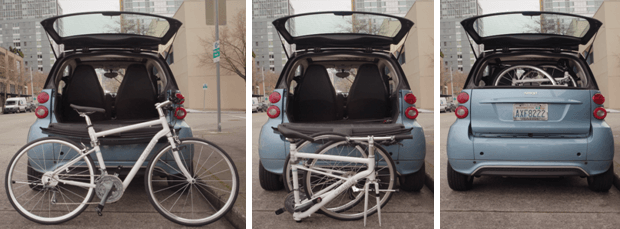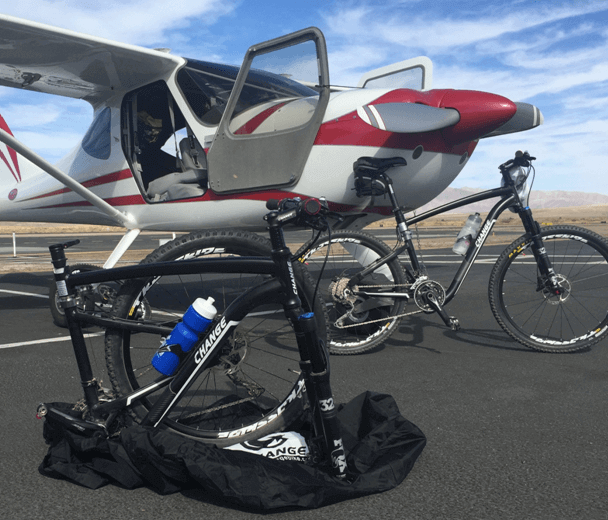* – This article has been archived and is no longer updated by our editorial team –
Below is our recent interview with Bob Forgrave, President at Flatbike:

Q: First, the obvious question… why would someone even want to fit a big bike in a Smart car?
A: It’s the ultimate test of a full-size bike fitting into your life. Naturally, you want to start with a very ridable bike, because that’s the whole purpose of having a bike—to do fun and useful things with it. But if it also folds quickly into a Smart car trunk, then it can fit neatly and securely in anyone’s car trunk, not visibly glommed onto the outside with some special attachment.
Suddenly, a full-size bike is easy to carry everywhere; it’s simple to add some easy riding into your workday, whether it’s riding in from the free parking areas or just chilling out on a safe local bike trail after work.
And if you don’t have a car, the story gets even better. A lot of our mountain bikes go to private pilots who need a way to get from remote airfields into town—or to even remoter adventures where there may not even be trails.
But you don’t have to own a plane to appreciate the ability to make a full-size bike fit quickly in small places. That herd of bikes in the way in the garage, that studio apartment that has dodgy bus service, the long-haul trucker who wants fitness on the road, that office that’s on the sixth floor after an elevator ride—these are all places where biking is a lot easier with a full-size bike that folds in half when needed.
Q: Normally, when we think of a “technology company”, we don’t think about bicycles. Is the cycling business a technology business?
A: It depends which end of the spectrum you’re on. At the front end, new developments are flowing into the consumer market from the racing circuit, involving tech-driven ways to eke out more performance with new composite materials often first introduced in the aerospace industry. In this respect, the bike business is much like the automotive marketplace, taking the latest racing advances and commercializing them. Are cars high tech? Even with more computerization every year, they’re not quite valued like tech stocks…and then Tesla came along and disrupted everything.
At the other end of the commercialization spectrum are discount bikes. Here, it’s purely a commodity business, taking older technology and making it cheaper to sell in high volume in discount stores. If what you’re selling has no unique value proposition other than being the current lowest-cost supplier, then you’re not a technology company.
Flatbike growth is driven by patented folding technology that no one else has.
Q: So did Flatbike invent this folding technology?
A: We did not. It was created and patented by Change bike, Ltd, in Taiwan and the UK. As Flatbike, we handle US and Canadian distribution of most CHANGE bike models, along with other unique components that we find around the world to make biking easier.
We’re closer to buyers, which offers a great opportunity to make the customer experience fantastic. Our optional add-ons might include a folding stem (so your bike fits flat against a wall), Flatbike-designed rigid seat bags, and flat-resistant tires now on the CHANGE 702 commuting bike. We’re also working on a new, demand-driven Flatbike road bike model on the CHANGE bike frame.
Q: These are the only folding bikes in the world certified for ruggedness. Is that a strategic advantage?
A: It’s an important differentiator for sure; there’s nothing like the confidence of knowing that your folding bike model has taking a beating 100,000 times from different directions before you decide to risk your body taking it over rocks and jumps. But EN-14866 certification is kind of a geeky thing. We’d be surprised if anyone outside of Europe looks for it before making a purchase decision.
Instead, our strategic advantage is the support of our own customers. We’ve got a TrustPilot score of 8.8 out of 10, across all four bike models, and routinely we hear from potential customers who heard about us from another enthusiastic customer.
Q: What’s your biggest business challenge?
A: We are creating a new market from scratch. The Lycra-clad Bicycling magazine readers who already build their lives around their bikes, from weighing carbon components to selecting a compatible bike transport vehicle, won’t be early adopters. But if you’re getting back into cycling, and want biking to be more convenient, or you want the full biking experience but have space challenges, then this is for you. Now all we have to do is build a market of all these folks who are on the periphery of cycling looking in.
The good news is, the cycling industry thrives on change, with new markets being created constantly. Back in the 70’s, biking either meant a one-speed learning bike or a 10-speed real road bike for going fast. The racing market will always be around, but along the way, new markets have evolved around rugged mountain bikes, single-speed city bikes (fixies), comfort bikes (cruisers), commuter bikes, folding bikes, recumbent bikes, tandems, and now electric bikes (e-bikes).
 Recommended: 6River Systems Raises $25M In Series B Funding Round, Announces Team Expansion
Recommended: 6River Systems Raises $25M In Series B Funding Round, Announces Team Expansion
Q: Where do you see cycling going over the next five years?
A: Now is an exciting time to watch the evolution of cycling, because e-bikes are explicitly not a racing market derivative; they are not even allowed in cycle racing. This makes them a 100% user-driven development, aimed at bringing non-cyclists into cycling. With an e-bike, any cyclist can ride anywhere (except in state and national parks) without fear of hills, going too slow, etc..
As non-geeky newcomers start buying e-bikes, how will the cycling media cover the growing market—as a more-speed/more-power techno-geekfest, or a story about the growth of cycling as part of the average person’s life style in the US? The quiet emergence of more consumers who use cycling just as an inexpensive and preferred method of transportation is potentially the biggest story of all.
And Flatbike will be part of that. After all, a full-size bike takes up space. More bikes take up more space. And eventually, the ability to cut that space in half grows from a niche market to a mainstream expectation.
Activate Social Media:


 Recommended:
Recommended: 